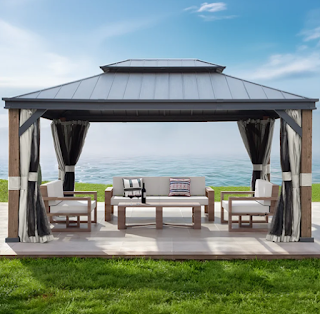Differences Between a Gazebo and a Pergola
One of the most fascinating things about nature is that we have absolutely no control over when the sun hits or doesn’t. Whether you are at a relaxing beachside spot or mountain getaway, there’s always the likelihood that the searing summer heat will mandate a wide-brimmed hat or periodic sunscreen application. In your backyard, though, you have total control of how you delight in open air. This time, though, you have the option to go with a gazebo or pergola, structures that offer a classic, trendy, and convenient approach to relax outdoors under a relaxing shade.
If you want
to find the ideal fit for you, then it’s vital to ask a few questions like “do
you want to make an outdoor room or just create an outdoor space cover?” also,
‘Do you want shade only or both protection and shade from external elements?”
However, these are simple basic considerations. To ensure you make the right
decision between a gazebo and a pergola to suit your needs, here is a detailed
comparison between the two and the major differences that distinguish them.
What is a Pergola?
In a simple
definition, a pergola represents a distinct structure designed from pillars or
vertical posts. Initially introduced in the 1640s, these remarkable modern
structures are made to support cross-beams to create a shaded passageway,
sitting area, or walkway. Generally, they can be designed from wood where wood
vines crawl across.
Typically, pergolas are mostly free-standing
structures, although you can get some unique wall-mounted options. These
structures are appealing and create a classic, remarkable focal point in
gardens, not to mention their practicability in forming a shelter in your
outdoor setting, allowing you to spend more quality time outdoors.
Alternatively,
they are also available as semi-structures, which are left up throughout the
year. Better yet, you don’t need any planning permission when assembling.
Pergola
roofs are usually open horizontal interlocking beams or lattice (made of aluminum,
wood, PVC, or steel) that provide partial shade. Vines and plants usually hang
from these beams to boost the shade/cover. You can also add some retracing
fabric canopies for a more complete cover, although they don’t provide complete
weather protection.
Pergolas are
ideal for placing your garden furniture beneath or for making sheltered space
over your hot tub. In fact, they are so flexible and convenient that you can
incorporate various functions like LED lights and motorized roofs.
At JOYSIDE, we offer pergolas with extra functions like louvred side walls, solid panels, and privacy screens, among others, for an ultimate experience.
What is a Gazebo?
Gazebos are usually
free-standing outdoor provisions, often turret or octagonal shaped mainly used
for shade. Gazebos usually comprise a solid roof boasting partially opened
sides to establish a shaded or sheltered area.
A gazebo can be
designed from various materials and can inspire various appeals depending on
the materials used. The most common gazebos are fabric gazebos and wooden
pavilions with the latter being fairly more permanent and the former can
usually be established and taken down regularly.
A gazebo is usually
viewed as a garden addition for various events and usually feel somewhat less
permanent. This is especially so for fabric gazebos since they are not
generally weather resistant or appealing.
Differences between a Gazebo and Pergola
While these two
distinct structures are a fantastic option, they are however not similar in a
number of ways. Here are the most notable differences between pergolas and
gazebos:
- Roof Canopy: the most notable difference
between pergolas and gazebos is the roof canopy feature. Ideally, gazebos
usually comprise permanent roof canopies, while pergolas comprise opening
or open roof canopies. Both of these units boast different cover levels,
but each creates fantastic outdoor living areas. Gazebos and pergolas
offer the flexibility to zone virtually any garden corners and most of
them can be placed over patios.
- Structure: another notable and
distinguishing factor between pergolas and gazebos is their underlying
structure. Ideally, pergolas offer a sleeker and more sensible option
compared to gazebos. Essentially, pergolas don’t always mean freestanding
structures and can usually be integrated or attached to your house or a
structure within the house. Pergolas are ideally a relatively more modern
unit that enhances modern architecture.
- Cost: despite both structures being
available in an assortment of kits allowing self-assembly, basic pergola
units are relatively cheaper and much more within the average DIYer’s
scope.
Which is the best fit between a Gazebo and a
Pergola?
The answer to which is the best outdoor structure between a
pergola and gazebo trickles down to three important factors: your budget,
location, and degree of weather protection needed. Although both structures are
available at JOYSIDE, a standard pergola is a much cheaper option and conveniently
within an enthusiastic DIYer’s scope. Essentially, pergolas are a fantastic
option since they become your home’s extension and encourage you to stay
outdoors more in a delightful outdoor space.

Comments
Post a Comment